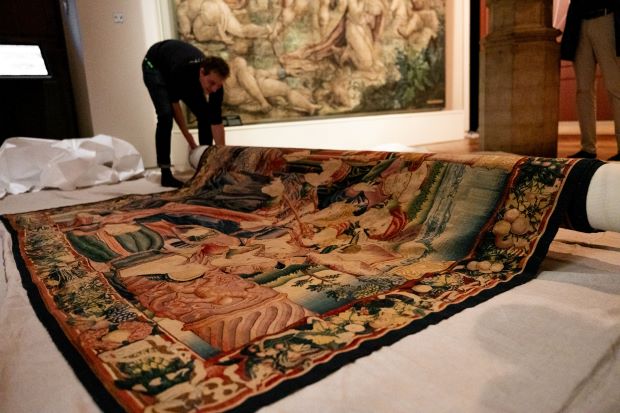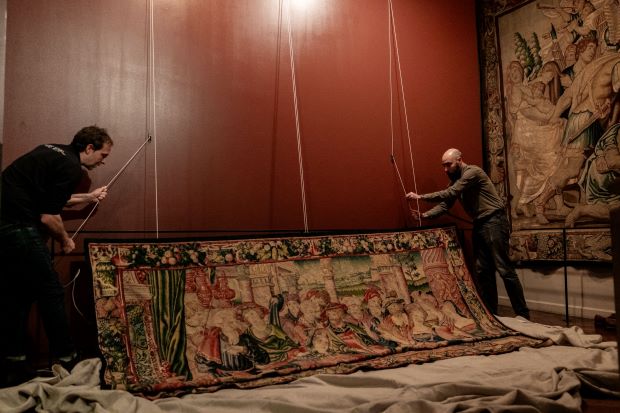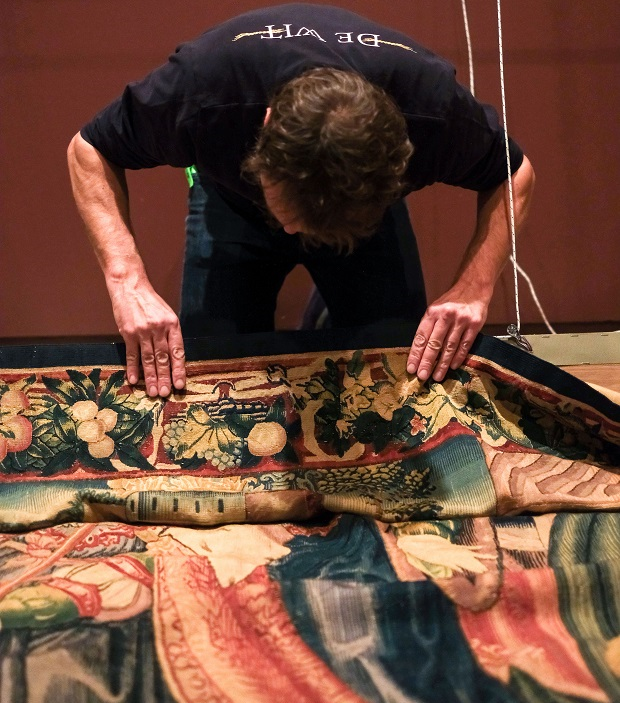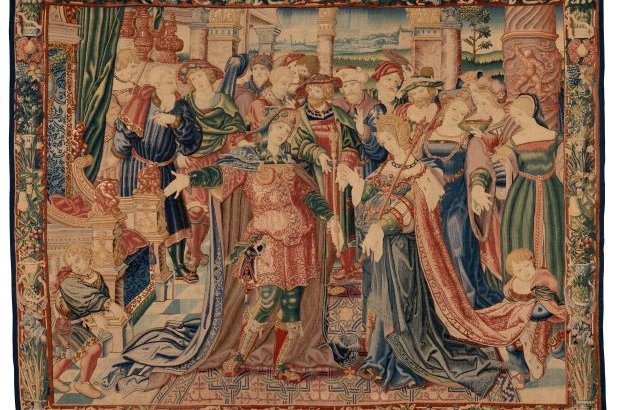- Daily & Weekly newsletters
- Buy & download The Bulletin
- Comment on our articles
Exceptional 1530 tapestry returns to its original Brussels location thanks to unique philanthropic partnership
A masterpiece 1530 tapestry woven in an atelier close to Brussels’ Grand Place is now on display in the medieval square’s Maison du Roi museum.
On public view for the next two years, the wool, silk and gold Renaissance work will then be placed in reserve for conservation reasons before being exhibited again.
King Solomon invites Bathsheba to share his throne is hanging in the neo-gothic institution with two other outstanding tapestries from the collection of Brussels City Museums.

This latest Roman-style acquisition, boasting a highly-structured composition, features the king and his mother surrounded by richly-robed rather faceless courtiers. It is exceptionally well-preserved with bright colours and an intact decorative border bearing the original Brussels stamp as well as a weavers’ mark that researchers have yet to identify.
Laboriously woven almost 600 years ago, the tapestry is testimony to the fine craftmanship of Brussels weavers. For a long period, the city was at the centre of the tapestry industry and wielded considerable international influence.
Its skilled artisans, members of historic guilds, were employed in weaving-merchant workshops, complemented by a complex network of cartoonists who originated from the Netherlands and Italy. Some 25% of people working in Brussels were connected to the industry.
The monumental frescoes commissioned by powerful and wealthy patrons recounted narratives of Biblical and Classical subjects that were visually rich depictions of virtues rulers should emulate.

This particular work is one of a series of six rare tapestries recounting the lives of Bathsheba, David and Solomon that previously hung in the dining room of the House of Lords in the United KIngdom. The property of Lord Rochdale, all six tapestries in the collection were sold in 1987.
When this fine example came on the market at the world’s premier art and antique fair TEFAF in Maastricht earlier this year, an unprecedented partnership was launched to bring the tapestry home to Brussels.
To preserve this piece of national heritage, the King Baudouin Foundation (KBF) purchased it with the support of the city of Brussels, the Périer-D’Ieteren Foundation and the non-profit heritage organisation De Wit. “It wasn’t a simple acquisition,” admits Brussels city museums’ curator Bérengère de Laveleye.
Among the outstanding features of the tapestry is its decorative border, explains Sacha Zdanov of the Périer-D’Ieteren Foundation. “It is characteristic of Brussels: we can see its weavers mark on one side and the Brussels mark BB on the other side.”

As for the vivid colour palette, he highlights the “soft greens that have maintained their yellow very well” as well as the delicate mauve revealed in the interior of Solomon’s cloak. “This is a very specific colour to tapestries, but in most of them, the colours quickly fade, which makes this one quite extraordinary.”
One of the tapestry’s historically fascinating elements is the inclusion in the top right-hand corner of a twisted column that was inspired by the Italian painter Raphael’s work for the Sistine Chapel in the Vatican.
“Pope Leo X ordered a series of tapestries of apostles and the models were made by Raphael. These models were sent to Brussels to be woven. When they arrived, these elements of the Italian Renaissance, such as the column with twists, created a visual shock,” points out Zdanov.

For the art historian, this tapestry is one of the finest of the series because of its tender portrayal of Solomon and Bathsheba. “In my eyes, he’s almost asking her to dance.”
Its return to the Belgian capital adds another layer of resonance. “When walking in the streets around the Grand Place, you can imagine how one of the tourist restaurants could once have been a workshop where it was woven some 500 years ago,” he says.
Photos: (main image) King Solomon invites Bathsheba to share his throne ©De Wit; Installation of the tapestry in the Maison du Roi museum ©Eve-Anne HKS



















